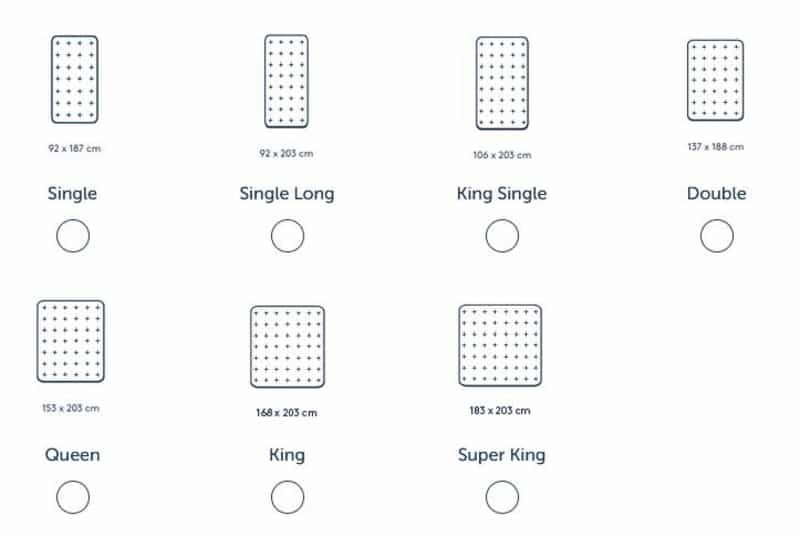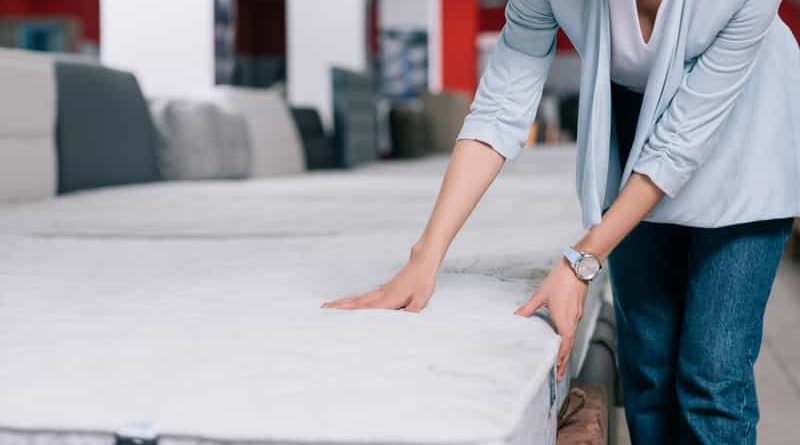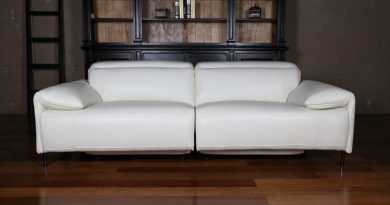Mattress Buying Guide: How To Choose your New Mattress
Sleep is an essential process in our daily routine. Your body slows down to heal itself, and it also replenishes your hormone and energy levels. Based on the body structure, you can survive for weeks without food but can only last for a few days without sleep. Hence, sleeping uninterrupted has been a priority since when humans were hunters & foragers. They used stacks of leaves and dried grass to create a cushion that assumed the shape of a sleeper. Thanks to modern technologies and advancements, mattresses are now made of sturdy and durable materials. Right from the box spring mattresses to those with memory foam, the choice is plenty.
Suppose you are looking for a mattress for your bed but unsure which would suit you, read this mattress buying guide ahead. If in a rush, you can also try our Bed Selector tool. It is an interactive questionnaire, which will suggest the right mattress based on your answers.
Benefits of Buying the Right Mattress
Some people can doze off at the drop of a hat while others experience ‘the princess and the pea” syndrome. Unless they are lying on a comfortable surface, they have trouble sleeping. No matter what category you may fall in, buying the right mattress is beneficial.
1) Disruption-free sleep
Usually, you sleep in 4-5 sleep cycles.
- Dozing off
- Body and mind slowing down
- Deep sleep – This is where your body goes into a recovery state
- REM sleep (Rapid Eye Movement)
It is easy for a person to awaken in the first two stages. Also, scientists say that the ideal bedroom temperature should be around 18.3oC for peaceful sleep. When you are lying on a mattress that provides enough back or prone support, you tend to move around very little. Moreover, if the mattress’s top layer remains cool, you won’t wake up feeling hot by wicking away the generated heat. Hence, you end up sleeping uninterrupted in a single posture for an extended time.
2) Maintain Proper Posture and Form
Depending on the sleeping position, you may exert unnecessary pressure on the different body parts. For example, sleeping on the back disrupts the natural curvature of the spine. Sleeping sideways or in a fetal position causes the neck and spine to curve unnaturally. Also, you apply pressure on your arm and shoulders when the head rests on an arm, restricting the blood flow.
Depending on your posture, a firm or soft mattress helps you maintain the natural pose. It also cushions the applied pressure. This way, you end up waking up without your joints creaking or feeling pins and needles in your limbs.
3) Improve the mental and emotional health
Chiropractor Stuart Craig says a good night’s sleep is vital. It allows you to wake up energized and alert. As a result, your brain makes stronger connections between the neurons. You feel energetic throughout the day and can focus on the task at hand. Whereas, due to lack of quality sleep, you wake up in pain and are cranky all through the day. Moreover, severe disorders such as ADHD, anxiety, depression, and poor cognitive functioning are linked to an extended period of sleeplessness.
4) Saves money
While you don’t get paid to sleep, you do save money when you sleep properly. When sleeping on the right mattress, you tend to move a little. So the lifespan of the springs or cushion in the mattress is automatically extended. Your body gets ample rest and heals better. Your mental health is at the peak. So, you save money on medical treatments for disorders linked to your sleep. Moreover, any mattress is a significant investment, so you save money on buying a durable one.
How to Buy the Right Mattress?
A visit to a mattress-selling website would show you a wide variety of mattresses. The amount of customization available would put the choice you get while assembling a sandwich in Subway to shame. Being confused, you opt for a quick Google search. The many articles would flood you with an extensive breakdown of the pros and cons of each mattress type. While this may be insightful, it is impractical to read a 3000+ word article, reflect on what you learned, and put it into practice when you browse the store for your ideal mattress.
Here, we will follow a step-by-step process to remove the choices based on criteria.
Step 1: Choose the intended user.
You can make a broad bifurcation based on the intended user. Couples opt for Double, King, or Queen size beds. Beds for kids or the spare bedroom can be single. In the case of couples, opting for a pocket spring mattress allows efficient weight distribution. When anyone changes their posture, the pocket springs function individually and keep other springs undisturbed. If you plan to install the mattress in an RV or a custom bed frame, you need to create a custom mattress.
Step 2: Determine the sleep posture
Generally, people tend to sleep in any of the following three postures:
- On their back
- On their side
- On their stomach

Then you have a separate species that cannot sleep without changing posture frequently. Usually, this would be due to some underlying issues such as:
- mattress heating up
- the bedding being stiff
- lack of airflow
You can solve these by choosing different mattress materials (explained later).
A firm mattress that keeps the spine aligned for anyone sleeping on their stomach. Those sleeping on their backs need a less firm (but not too soft) mattress. It adjusts itself to support the spine and neck region without altering the natural curvature. As mentioned earlier, people sleeping on their sides need a soft mattress. It will contour itself to cushion the pressure exerted on the different body parts. On a scale of 1-10, with 1 being the softest and 10 being equivalent to sleeping on a bed of bricks, the firmness range for each sleeper type is:
- Sleeping on the back – 4 to 7
- Sleeping on the stomach – 5 to 7
- Sleeping on the side – 3-6
One thing to keep in mind is that the firmness of a mattress also depends on the weight the mattress can tolerate. Anyone heavier than 90kgs might find a mattress built to bear up to 85kgs, too soft and vice versa.
Step 3: Determine the Material
The bulk of the mattress should be a material that can bear the weight of those sleeping on it. Hence most mattress manufacturers tend to stick to the following four material types:
1) Coils
Coiled metal provides springiness while being firm. If the springs formed from a single piece of metal, it is called a continuous coiled mattress. They are comparatively lightweight and cheaper than the rest. Since they are made from a single piece of metal, you cannot repair them easily.

(Image Source: Wikipedia)
Suppose the springs are enveloped in individual fabric pockets and arranged in a grid. In that case, the mattress type is called Pocket Spring Mattress. As stated earlier, a pocket spring mattress allows springs to function individually to manage weight distribution. Hence, you don’t end up waking your partner up with the fear of tremors anytime you change your posture. Since they are individual springs, repairs are easier.

(Image Source: Wikimedia)
Air flows easily inside coil mattresses and hence tends to remain cool throughout.
2) Foam
Foams are a pinnacle of comfort. They are springy and can take up the negative space of anything you place on them, making it body-hugging. These mattresses are generally single-piece polyfoam or different foam types to make them more adjusting (memory foam). Unfortunately, they are super dense materials and can become hot due to the lack of airflow. Moreover, the pores in the foam are super absorbent. As a result, they can become a hotbed (pun intended) for dust, mold, and bacteria by absorbing the sweat.
3) Latex
A mattress made up of natural or synthetic latex is more breathable and won’t heat up as much. Moreover, it won’t collect dust, so it is allergen-safe. Owing to the elastic property of latex, the mattress moulds to the body shape easily. Quality is of utmost importance here. Low-quality latex tends to clump together after some time.
4) Hybrids

These mattresses give the users the best of both worlds. Structurally, these mattresses have a coil spring bulk for rigidity with a 2″ latex or foam top layer for comfort. These are suitable for those who tend to move around while sleeping, changing positions frequently.
When it comes to lifespan, the average durability of each type is:
- Latex – 12 years
- Foam – 10 years
- Hybrid – 10 years
- Coil – 8 years
Step 4: Go for the correct size
When it comes to bed sizes, there is a total of six sizes to choose from:
- Single – 92x188cm
- King Single – 92x203cm
- Double – 106x203cm
- Queen – 153x203cm
- King – 168x203cm
- Super King – 183x203cm

For couples or those who demand ample bed space can opt for anything above the double bed.
Step 5: Making the purchase
Assuming that you have zeroed in on your preferred mattress type, it is now time to buy. Depending on your needs, the mattress combination will have different price points. The following is an approximate estimate for a queen-size bed:
- Pocket Spring – $999
- Latex – $2499
- Foam – $1049
- Hybrid – $3999
The next dilemma would be where to buy it from? Physical stores allow you to “test ride” your bed and get the touch and feel of different mattress types. Whereas online stores periodically offer discounts or promotions to buy the mattress for a lower price. You can opt for retailers such as Brownies Mattress Direct, who sell by eliminating the middleman. This way, the savings benefit the end customer. It is advisable to visit the physical store once before buying your mattress (even if you opt to buy it online.)
Tips to follow when visiting the physical store
- Never shop tired – A tired body will find comfort in all types of beds. When out buying a mattress, ensure you are not fatigued. This way, you will make a better judgment.
- Check the weight – This will help you make arrangements for transportation and rotation.
- Lie down – The mattress you would buy would be the one you will be lying on for years to come. You must test it out while in the store. Check the comfort level while lying, getting up, and rolling around on the mattress to understand the firmness. Also, bring in your partner if you are planning to buy the couple’s mattress.
- Don’t trust the display model – Several people would have tried the display model. Days or even months of ‘testing’ would have compromised its performance.
- Ask for returns and warranty – Most mattress companies offer 100 nights trial. It means you can get your mattress exchanged if you are not satisfied sleeping on it for 100 nights.
Wrapping Up
Congratulations. You are on your way to buying your next mattress. All that now remains is checking the mattress for defects on delivery. Also, ensure that you rotate the mattress every 3-4 months to extend its lifespan. Brownies Mattress Direct is a mattress retailer with five outlets across.




